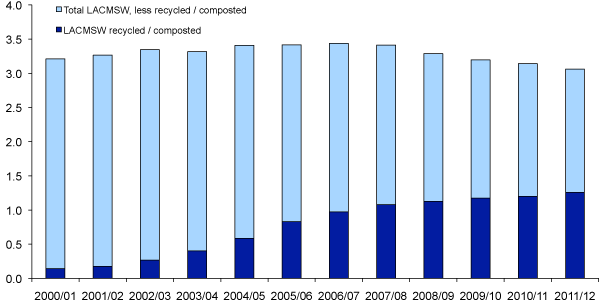Key Scottish Environment Statistics 2013
This publication aims to provide an easily accessible reference document which offers information on a wide range of environmental topics. It covers key datasets on the state of the environment in Scotland, with an emphasis on the trends over time wherever possible. The data are supplemented by text providing brief background information on environmental impacts, relevant legislation and performance against national and international targets.
Local Authority Collected Municipal Solid Waste (LACMSW)3,4: 2000/01-2011/12
Million Tonnes

The strong historic dependence on landfill for waste management in Scotland is unustainable since it involves the depletion of both renewable and finite natural resources. In addition, extracting and processing raw materials may consume large quantities of energy, release pollutants and destroy landscapes and ecosystems. Reducing, re-using and recovering waste are key to sustainable development and Zero Waste objectives.
Local authority collected (LAC) municipal waste arisings rose from 3.21 million tonnes in 2000/1 to 3.44 million tonnes in 2006/07, before falling to 3.06 million tonnes in 2011/12. Over the same period the percentage of LAC municipal waste recycled or composted rose from 4.5% to 41.2%. This reflects an increase in the amount of material recycled or composted of over 900%. The amount of MSW being sent to landfill as a percentage of total LACMSW arisings has decreased steadily between 2000/01 and 2011/12 from 94% to 56% respectively
The National Waste Plan8 set a target of stopping growth in municipal waste by 2010. In 2008, the Scottish Government also set targets9 to increase the amount of municipal waste being recycled or composted to 40% by 2010, 50% by 2013, 60% by 2020 and 70% by 2025.
These targets have been included in the Zero Waste Plan10 issued in 2010, but have been revised to apply to waste collected from households. This was accompanied by a new approach to assessing recycling rates based upon carbon. Future assessments of recycling rates will include a carbon measure, thereby helping to target recycling efforts at those materials with the highest environmental impacts. The Zero Waste plan also established a target to achieve a 70% recycling rate and 5% landfill rate by 2025 for all wastes, not just municipal waste
Contact
Email: Callum Neil
There is a problem
Thanks for your feedback